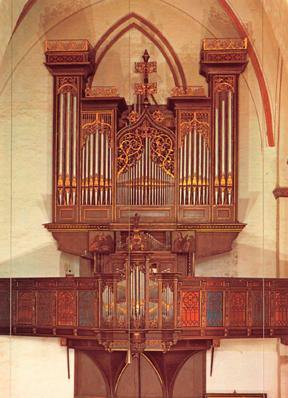
 In August
1999, Armin Schoof, a professor of music and the organist at St. Jakobi Church
in Lübeck, Germany, discovered severe cracks and holes in the lead pipes
of the church’s famous Stellwagen organ. Fearing the loss of the 15th-century
instrument, Schoof contacted researchers at the Göteborg Organ Art Center
at Göteborg University, Sweden.
In August
1999, Armin Schoof, a professor of music and the organist at St. Jakobi Church
in Lübeck, Germany, discovered severe cracks and holes in the lead pipes
of the church’s famous Stellwagen organ. Fearing the loss of the 15th-century
instrument, Schoof contacted researchers at the Göteborg Organ Art Center
at Göteborg University, Sweden.
Lead and lead-alloy pipes in the Stellwagen organ at St. Jakobi Church in Lübeck,
Germany, are corroding away. The organ was built in 1467, and still contains
original pipes. Researchers are working to determine the cause of the decay.
Courtesy of Carl Johan Bergsten.
Carl Johan Bergsten, a research engineer at the Göteborg Organ Art Center,
gathered together a team of metallurgists, environmental chemists and organ
restorers, and they soon found that the problem was more widespread: Of the
10,000 historic instruments remaining in Europe dating from the 15th to 17th
centuries, the mysterious deterioration has already affected more than 1,000
— and possibly more. During the last few decades, this deterioration has
accelerated. Unchecked, the corrosion of the metal pipes will change the sounds
of these historic artifacts, perhaps even silencing them.
Most organ-builders restoring or repairing historical organs find pipe corrosion.
Corrosion usually begins with cracks and holes in the foot of a metal pipe and
continues to move upward toward its mouth, eventually causing a complete collapse.
“If the corrosion reaches the mouth, the sound properties will gradually
change and finally the pipe will be silent,” Bergsten says. “This
is serious because the historical sound quality will be lost and the sounding
cultural heritage is forever gone.”
Bergsten says that it is too early to draw any final conclusions about the cause
of the corrosion. The project that he leads, called the Corrosion of Lead and
Lead-Tin Alloys of Organ Pipes in Europe project (known as COLLAPSE), is addressing
many factors inside churches, including changing temperature, humidity and condensation
and indoor pollutants, such as acidic vapors released by wood in the organ.
The researchers are also considering outdoor pollutants emitted from traffic,
agriculture and industry.
Team members are now analyzing samples from affected pipe organs in Italy, Belgium,
the Netherlands and Germany, and comparing them to samples from unaffected organs
in similar climatic regions. Preliminary findings show that alone, inorganic
pollutants, such as sulfur dioxide and nitrogen oxides, do not seem to be the
culprit. However, Bergsten says, a combination of the factors could be causing
the corrosion, something the team will test in field and laboratory analyses
of different pollutants interacting in varying environmental conditions.
Researchers do know that not all types of pipes are equally prone to corrosion.
Carla Martini, a metallurgist at the University of Bologna in Italy, says that
so far, most analyses have been of lead-rich pipes containing less than 4 percent
tin by weight. “The extent to which [the pipes] are affected by corrosion
in a given environment changes with the composition of the alloy, namely with
the tin content,” Martini says, with the most corrosion found in pipes
containing 1.5 to 2 percent tin.
In some cases, earlier attempts at conservation might now be causing corrosion.
While investigating the Stellwagen organ, researchers discovered the powdery
residues of lead compounds that are usually produced by interactions with organic
acids. Analysis of the air inside the organ found high concentrations of acetic
acid, which corrodes lead even in very low concentrations. “Wood, especially
oak, is known to emit organic acids,” Bergsten says, and the acetic acid
may be from oak that was used to repair the wooden windchests and wind system
of the organ in the 1970s.
Developing better conservation strategies is one of the main goals of the project,
which is supported by the European Union. By understanding the sources of corrosion,
it might be possible to change an organ’s environment to protect it. If
not, researchers are also developing protective treatments that could be applied
to the surface of a pipe. They expect to test experimental conservation strategies
on the Stellwagen organ by 2005.
Sara Pratt
Geotimes contributing writer
 |
Geotimes Home | AGI Home | Information Services | Geoscience Education | Public Policy | Programs | Publications | Careers |